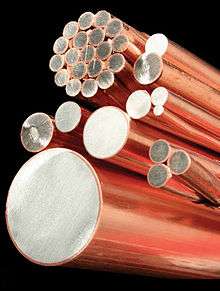Copper-clad aluminium wire
Copper-clad aluminium wire (CCAW or CCA) is an electrical conductor composed of an inner aluminium core and outer copper cladding.

Uses
The primary applications of this conductor revolve around weight reduction requirements. These applications include high-quality coils, such as the voice coils in headphones or portable loudspeakers; high frequency coaxial applications, such as RF antennas and cable television distribution cables; and power cables.
CCA was also used in electrical wiring for buildings. The copper/aluminium construction was adopted to avoid some of the problems with aluminium wire, yet retain most of the cost advantage. In the US, solid copper is most commonly used in internal residential 120 V or 240 V wiring.
CCA is also seen in unshielded twisted pair networking cables.[1] These cables are often less expensive than their full-copper counterparts.
Properties
The properties of copper-clad aluminium wire include:
Skin effect
The skin effect causes alternating current to concentrate on the more-conductive copper cladding of the conductor, causing the resistance of the wire to approach that of a pure copper wire at high frequencies, which makes the copper-clad aluminium wire a good fit for such applications. The skin effect is also utilized in copper-clad steel wire such as RG-6 coax, which is also commonly used in high frequency applications with high strength requirements.